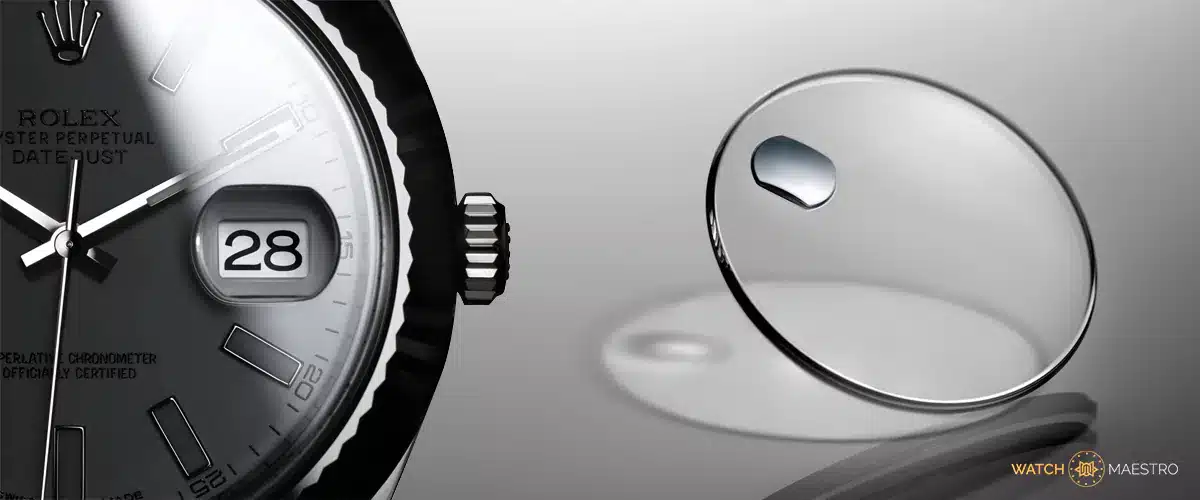How does the Cyclops Lens work
Most of the Rolex models that feature a date window are accompanied by something called a Cyclops lens. It is basically a convex lens that is placed right over the date window on the crystal of the watch. The lens magnifies the date by exactly 2.5 times and makes it more legible. Just like the glass of the watch, the lens is also made using sapphire crystal. It is both durable and scratch-resistant.
In terms of its functionality, when light passes through the lens, it is refracted, causing the image of the date to appear larger than it is. The magnifying lens has to be perfectly placed in a way that it gets positioned directly above the date window. The center of the lens should be aligned with the center of the date display. If it fails to align, Rolex has to change the whole sapphire crystal during the production process.
The patented Cyclops lens becomes so much more interesting when you find out that the lens has been formed on the crystal itself during the manufacturing process. This is what ensures that the lens is perfectly aligned and integrated with the watch, giving it a seamless appearance.
What might look like a simple feature now, was actually one of the best innovations made by the Swiss watch manufacturer.
History & Significance of the Cyclops Lens
Rolex first introduced the Cyclops lens back in 1953. Even though the technology was patented in the early 1950s, it was not until 1953 that the special lens was featured on a Rolex Datejust. At the time, the magnification lens was a revolutionary feature that quickly became a signature of Rolex watches.
The lens already came with the models that were launched after 1953 like the GMT-Master and the Day-Date. While the initial Submariner models did not feature a date window, with the launch of the reference 1680 in the 1960s, Rolex brought both a date window as well as the Cyclops lens to the divers watch.
Rolex derived the term Cyclops from Greek mythology. Cyclops was a one-eyed giant who had a single eye in the middle of his forehead.
Even though the functionality of the lens has remained more or less the same, Rolex did make some improvements over the years. Initially, the Cyclops lens was made on a Plexiglass, as Rolex used that instead of Sapphire Crystal back in the 1950s. In the 1970, Rolex introduced the Sapphire crystal, which was virtually scratchproof.
Besides improving the durability of the glass, the sapphire also doubled the anti-reflective coating for better legibility of the date window.
Current lineup of Rolex watches featuring the Cyclops Lens
Most of the Rolex watches that feature a date window get a Cyclops lens on the crystal. These include the following models:
- Rolex Datejust – It was one of the first Rolex models to get a Cyclops lens and it still continues to feature one. It was a feature that distinguished the model from all the other models.
- Rolex GMT Master II – After the Datejust, the GMT Master collection was the first to get the special lens. Combined with the GMT function, the magnifying lens and the date window make it for the perfect traveler’s watch.
- Rolex Day-Date – The Day-Date collection features both a day and a date window. However, the date window is the only window that gets a Cyclops lens increasing the legibility of the date on the watch.
- Rolex Submariner – Submariner is available in both Date and No Date models, with the Date model being the one to feature the special lens.
- Rolex Explorer II – Designed for outdoor enthusiasts, Explorer II is another Rolex watch that gets a date window combined with a magnifying lens.
- Rolex Sky-Dweller – The Sky-Dweller is one of the most complicated watches ever produced by Rolex. That being said, they had to add a Date window to make it an ultimate travel companion. With the date window, the watch also gets a magnifying lens on its sapphire crystal.
- Rolex Yacht-Master – Designed for sailing and boating enthusiasts, the Yacht-Master also comes with a date window combined with the magnifying lens.
- Rolex Sea-Dweller – The regular Sea-Dweller model also features a magnification lens on the date window, making it easier for divers to read the date underwater.
This shows that Rolex has added the lens on every Rolex watch that features a date window. However, there is one model that does not. Rolex Sea-Dweller Deepsea is the only model in the Rolex lineup that features a date window but misses out on a Cyclops lens.
This is due to the fact that the Sea-Dweller Deepsea has a doomed sapphire crystal for better water resistance. Due to that, it was harder for Rolex to also fit in a Cyclops lens. Hence, it became the only watch to get a date window but not the special lens.
Things that make the Cyclops lens feature special
When you are looking for a watch with a date window, you will be greeted by a plethora of options. However, everyone agrees that no one does it better than a Rolex. This is due to the Cyclops lens feature. Every watch brand does something to make the date more legible. Some use bigger date windows, while others just play with the font. It is only Rolex that keeps it consistent across all watches with the patented magnifying lens.
Cyclops lens also helps the brand fight counterfeiters. With the lens magnifying exactly 2.5 times, it is extremely hard for people to replicate it. Furthermore, Rolex seamlessly fits the lens into the sapphire crystal, which is unachievable by many manufacturers.
